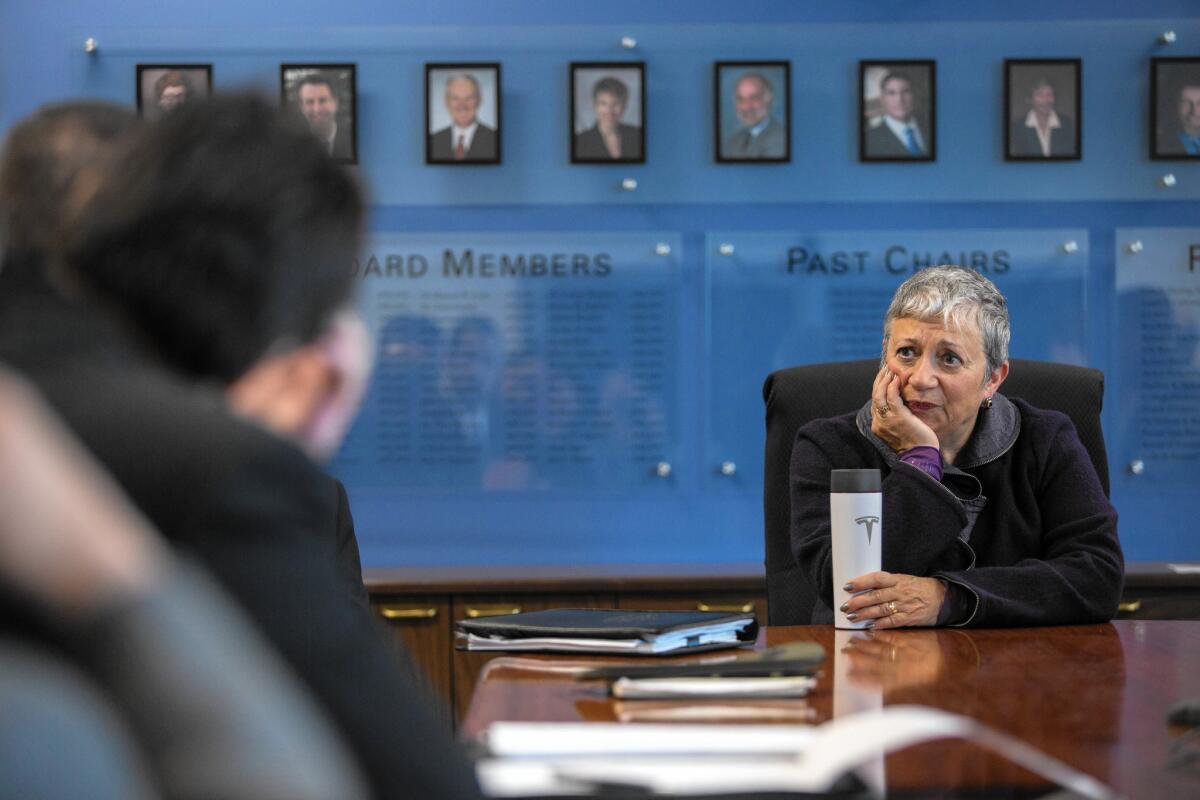Mary Nichols has ‘rock star’ influence as top air quality regulator

- Share via
Reporting from Sacramento — A meeting with Gov. Jerry Brown and Chevron executives was ending when an oil company official turned to Mary Nichols, California’s top regulator for air pollution.
There was only so much Chevron could do to meet the state’s rules, he told her. “I know we’ve told you before that we couldn’t do things that you wanted us to do, and then we’ve turned around and succeeded,” he said. “But this time we really mean it.”
The October conversation, recalled by Nichols in a recent interview, echoed many others in her decades-long career as an environmental lawyer and regulator.
Once it was car companies fighting her efforts to reduce the smog choking Los Angeles. Now it was the oil industry resisting gasoline restrictions intended to stem climate change.
“They’re just being irritating,” she said.
As chair of the Air Resources Board, Nichols plays a central role in deciding where Californians get their energy, what fuel goes in their cars and how their homes are built. She also oversees the state’s ambitious program for reducing greenhouse gas emissions, one that analysts say could be a model when world leaders hold their environmental summit next year in Paris.
And although California already has some of the strictest pollution regulations in the country, Nichols is helping to lay the groundwork for more.
“It’s on people’s minds right now,” Nichols said. “While the momentum is strong is the right time to act.”
State lawmakers are discussing further rules on pollutants such as methane, setting new emissions goals for the decades ahead and increasing the efficiency of moving water around the state. New policies from the Obama administration, intended to reduce pollution from power plants, could also create opportunities for Nichols to partner with other states.
“Climate change is the biggest issue our generation has ever faced. And she’s the person leading the way to find the best solution,” said Carol Browner, a former environmental advisor to President Obama.
Brown has signaled his desire for new climate-change initiatives, and his partnership with Nichols dates to the 1970s, when he made her chair of the Air Resources Board for much of his first two terms as governor.
After Brown left office, Nichols’ career resembled a grand tour of California’s environmental world: opening the Natural Resources Defense Council’s Los Angeles office, leading the Environment Now foundation, serving as resources secretary for Gov. Gray Davis. In a detour to Washington, she worked in the Environmental Protection Agency under President Clinton.
Now Brown and Nichols are back in the same jobs they had 40 years ago. The governor calls her a core member of a long-standing team, saying, “She has good judgment, and she knows the field.”
Nichols, who will be 70 in April, keeps a punishing schedule. One recent morning she awoke at 4 a.m. in her Los Angeles home to make a 6 a.m. flight to Sacramento, where she attended a breakfast reception hosted by a California think tank.
Toting her bright red rain jacket, she chatted with a business leader about making commercial buildings more energy efficient, then gabbed with a political consultant about public opinion on environmental issues.
Afterward, she headed to her office for a day of meetings. A music poster on the wall there is a reminder of what she called a “sacred custom,” attending the annual jazz festival in New Orleans. She sang in her church choir and belted out tunes at a recent birthday party.
On Nichols’ desk was a note that came with a bouquet of flowers, in gratitude for an event she helped organize in Sacramento. “You are the best,” it said. “Love, Arnold.”
That’s Arnold Schwarzenegger, the movie star and former governor who brought her back to the Air Resources Board in 2007. A new law required the state to reduce greenhouse gas emissions by 2020, and it gave the board wide latitude to determine the approach.
Nichols, a Democrat, was skeptical of Schwarzenegger. The last time California was led by a movie star Republican — Ronald Reagan — she was working at a nonprofit and suing the state in an attempt to force its compliance with federal laws on air quality.
It was a decision in keeping with her activist roots. As a high school student in upstate New York, she gathered with classmates on weekends to talk about Cold War militarization and about improving living standards for farmworkers. She refused to participate in an air raid drill, instead walking the streets with her friends, expecting to be arrested and being slightly disappointed when she wasn’t.
Years later, her father became the Socialist mayor of Ithaca.
“He spent most of his time protecting the downtown merchants against competition from Wal-Mart … keeping the post office open, and getting enough money to keep the police force going,” Nichols said.
And he tried, albeit unsuccessfully, to issue a marriage license to two gay men in Ithaca, almost a decade before Gavin Newsom stirred controversy by allowing gay couples to marry when he was mayor of San Francisco.
She got a taste of the issue that would define her career when she was a law school student at Yale — Brown’s alma mater, and a source for many of his appointees. In Los Angeles on a road trip with a classmate, Nichols was struck by the color of the sky — “a peculiar, Day-Glo, chemical kind of orange,” she once recalled.
Eventually, she joined forces with Schwarzenegger, who had won her over, and they developed the cap-and-trade program, which requires polluters to buy credits to emit greenhouse gases.
That program, and California’s status as the world’s eighth-largest economy, have given Nichols outsized influence for a state regulator. Supporters describe her as a “rock star.”
Still, there’s been near-constant resistance to cap-and-trade, said Virgil Welch, a political advisor to Nichols. He characterized the opposition’s position as: “If we fail at this step, we’ll try the next step. We’re going to try and stop you every step of the way.”
Opponents are reluctant to criticize Nichols publicly. The Western States Petroleum Assn., which has backed a web of groups battling cap-and-trade, declined to comment.
Allan Zaremberg, president of California’s Chamber of Commerce, which has sued over the cap-and-trade program, was circumspect.
“She doesn’t always agree with the same solutions we might have in mind. But it’s always good to have disagreements with someone you can respect,” he said.
Republicans in the Legislature remain opposed to cap-and-trade. And a crop of moderate Democrats lately has been more eager to embrace business interests than environmentalism. They include Assemblyman Henry Perea (D-Fresno), who expressed concern that cap-and-trade would lead to higher gas prices by raising the cost of doing business.
The program should be modified, he wrote in a June letter with other Democratic lawmakers, so it “avoids unnecessarily increasing fuel costs and putting the brakes on our economic recovery.”
Nichols didn’t budge. It’s important to bring fuels under the emissions cap, she said in a letter the following month, because gasoline-powered transportation emits 40% of greenhouse gases in California.
Then she addressed the issue of gas prices head-on, saying they would vary “unless there were to be unlawful collusion on the part of the industry” to raise them.
“In a democracy, it’s always easier to put off tough decisions than it is to make them,” Nichols said. “Every pound of greenhouse gas that we keep out of the air today is worth more than a pound we keep out 10 years from now.”
Twitter: @chrismegerian
More to Read
Sign up for Essential California
The most important California stories and recommendations in your inbox every morning.
You may occasionally receive promotional content from the Los Angeles Times.











